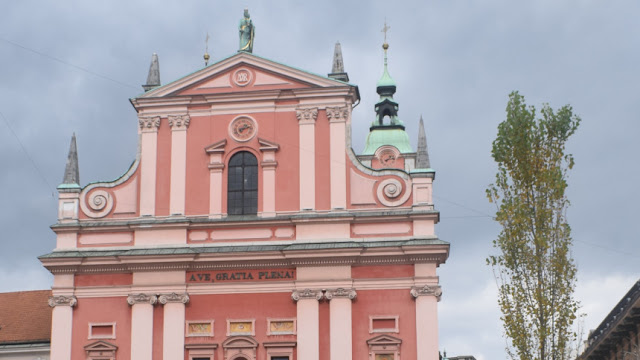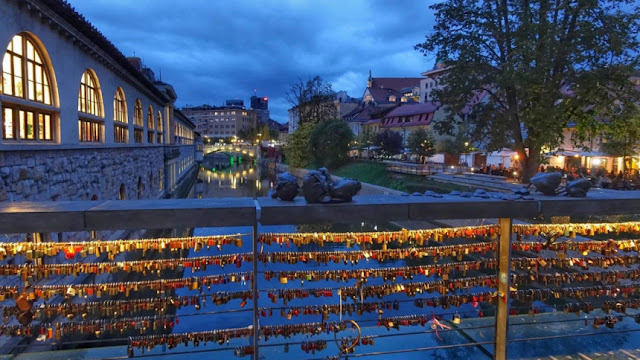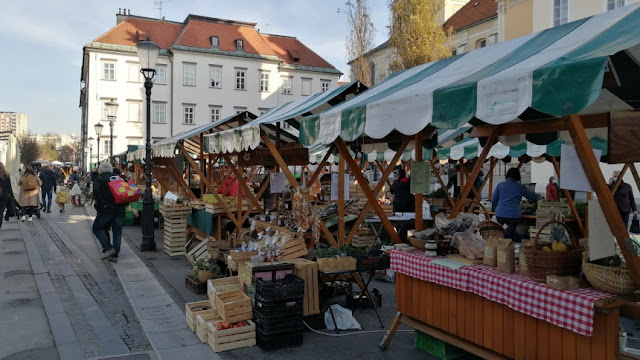 |
| Lubliana Cathedral. |
In Europe, the name Lubliana is ignored in the crowds of cities like London, Paris, Amsterdam, Berlin, Lisbon, Barcelona, Madrid, Copenhagen, Stockholm, Rome, Milan, Munich or Vienna. Even for travelers to Europe, Lubliana is less important.
But when a Slovenian is asked about Lubliana, they will say in one sentence, "There is no other city in Europe as neat and tidy as Lubliana."
Slovenians love their capital city very much.
One day after class, my classmate Peter Brumat said in a chat, 'We named it Lubliana out of an innate love for the city. Believe it or not, I swear there is no heavenly city in the world like Lubliana. '
Since there was no Slovenian embassy in Bangladesh, I had to go to Delhi to collect a Slovenian visa. During the visa interview, the visa officer asked me, 'What do you know about the capital of Slovenia?'
I said, "As far as I have learned that Lubjana is the capital of Slovenia." The visa officer stopped me and started laughing out loud. He later told me that although the Latin letter 'Lubliana' was written, the correct pronunciation was Lububiana. So at first the foreigners made a mistake.
Exactly when the Lubliana was settled is not clear. However, according to archaeologists, the area was inhabited long before the birth of Jesus Christ. At that time small and large wetlands existed in various places in the vicinity including Lubliana. These wetlands are collectively called 'Lubliana marshezes'. In prehistoric times, the way of life of the people of the surrounding areas, including Ljubljana, was marine. The artefacts they created are still the subject of archaeological research.
The name of the oldest wheel ever discovered in the history of human civilization is 'Lubliana Marshall Wheel'. The 5,000-year-old wheel is now preserved in the City Museum of Ljubljana.
The Romans set foot in Ljubljana around 50 BC. The Romans set up camp in Ljubljana. In 452 AD, a group of Han troops led by Attila invaded the surrounding areas, including Ljubljana. Astrogoths and Lombards also began to dominate the region.
For those of us now known as Slovenians, their first arrival in Ljubljana is thought to have taken place in the sixth century. Ethnically Slovenians are known as Slavic.
 |
| One of the attractions of Preseren Square is the Franciscan Church, built in the seventeenth century in the style of Baroque architecture. |
Modern Lubliana originated in the Middle Ages. Especially in the fifteenth century, Lubliana became particularly popular in Central Europe in painting and sculpture. In 1258, when King Ulrich III of Carinthia moved from Kamnik to Ljubljana, the provincial capital of Carniola, the city became increasingly important in local politics. In 1260, the ruler of Bohemia, Otto, captured Lubliana II. But after her fall in 128, Lubliana came under Rudolf of Habsburg.
During the Austro-Hungarian rule, Ljubljana became a major trading center for Austria and various parts of present-day Italy.
After the First World War, the Austro-Hungarian Empire collapsed. After World War I, Croatia, Slovenia, Macedonia, Bosnia and Herzegovina and Montenegro jointly formed the Yugoslav Federation, led by Serbia. In World War II, Mussolini's army occupied Ljubljana. They claim Ljubljana as part of Italy. World War II saw the defeat of the Axis Powers led by Germany and Italy. With the end of World War II, Slovenia returned to the Yugoslav Alliance. During Yugoslavia, Slovenia was the Socialist Republic of Slovenia. Its capital was Ljubljana.
On June 25, 1991, Slovenia became the first country in the Yugoslav Federation to declare independence. However, other countries of the Yugoslav Federation, including Serbia, refused to accept the declaration of independence. The war began. This is the first war on the continent of Europe since World War II, in which 6 people lost their lives. In the post-independence period, attempts were made to transform Ljubljana into one of the most important cities in Central Europe. That effort continues today.
Slovenia became a member of the European Union in 2004. Since then, Ljubljana has gradually become important in Central European politics. Not to mention a man in the history of Ljubljana. He is Yoge Plechnic. He designed many important installations in the city of Lubliana.
As I said before, Ljubljana is not that big in size compared to other capital cities in Europe. The city still bears the imprint of communism. The farther you can get out of the center, the more you can see the light yellow residential buildings built during the communist regime. Over time, these residential buildings have lost much of their luster and faded. Even the country's public transport service is not like other cities in Europe. Most people in Slovenia rely on their own vehicles to travel. That is why the government of the country does not give importance to public transport in that way. It is true, however, that Lubliana has direct or indirect bus connections with almost all important cities in Europe.
While most European cities have trams or metros, Lubliana does not yet have these two services. So the public transport here is basically bus. There are some special rules to follow when using a bus inside the city. You need to buy the bus card separately and recharge the bus card regularly. If you want to travel by bus inside Lubliana, you have to pay 1.30 Euros per ride.
The term 'multicultural' does not apply to Lubliana. With the exception of Bosnia and Herzegovina, Serbia, Macedonia, Kosovo, Croatia and Montenegro, Slovenia has very little immigration from other countries. And for those who are addicted to nightlife, Lubliana will seem like a dead city to them. The nights in Ljubljana are not as lively as in Barcelona, Amsterdam, Lisbon or Madrid. Occasionally there are bars or nightclubs, but only the younger generation is there.
Slovenia has a much lower divorce rate than other European countries. Even in Slovenia, joint families still meet. Most Slovenians love to enjoy spending time with family. Like Dhaka, the roads in Ljubljana are quite narrow. However, there is no traffic jam. The standard of living in Lubliana is still not as high as in cities in Western Europe.
Preserren Square is the heart of Ljubljana. It is named after the Slovenian national poet France Preseren. The Pressuren Square is a 10-minute walk west of Lubliana's Central Railway Station. Locals gather here for movements or programs ranging from national festivals. During the weekends, small temporary shops sit in its vicinity. Most of the shops are very old. Many people from far and wide gathered here in search of various antiques, ranging from coins and stamps used during the Yugoslav rule.
 |
| Portraits of Slovenian national poet Fran Preseren and Mujes, the goddess of literature, science, and painting in Greek mythology. |
Preserren Square is relatively old compared to other parts of Lubliana. Most of the sights of Ljubljana are in its vicinity. Upon entering Presence Square, the first thing you see are two bronze sculptures on the east side. One of these is dedicated to the Slovenian national poet Fran Preseren. The other sculpture is of the Greek goddess Mujes. The famous Slovenian sculptor Ivan Zyich is the original architect of two sculptures.
One of the attractions of Preseren Square is the Franciscan Church, built in the seventeenth century in the style of Baroque architecture. Most visitors to Ljubljana love to take pictures while standing in front of this red church. With the spread of Catholic Christianity in the Middle Ages, Pressure Square became an important place for the practice of knowledge.
In the evening another look at Preseren Square catches the eye. At the end of the day, many people come to the nearby coffee shops and pastry shops in search of peace. There is street music to entertain pedestrians. In the evening, the whole Pressure Square became abuzz with the melody of songs and musical instruments.
Just opposite the Franciscan Church is the Triple Bridge of Ljubljana, just south-west. It is made up of 3 bridges. Historically the Triple Bridge of Ljubljana has a distinct significance. The bridge is flooded with colorful lights at night. It would not be wrong to call the other side of the bridge the Old Town of Ljubljana. However, it cannot be said that the Old Town of Ljubljana is too large. The Old Town is a unique example of medieval architecture. Slovenia has a reputation for making wines from a variety of fruits, including grapes. So the bars in the Old Town are crowded with visitors most of the year to taste Slovenian wine. Pair of souvenir shops in Old Town to buy good quality souvenirs. The price is a bit high.
Another attraction of the Old Town is the Lubliana Cathedral. Officially, however, it is called St. Nicholas Cathedral. It was built around 1272. The cathedral was rebuilt in the eighteenth century in the style of Baroque architecture.
When we hear the word 'dragon', the image of China comes to our eyes. Like China, the local people of Ljubljana feel that dragons are an integral part of their culture. It would not be wrong to call the dragon the symbol of the city of Lubliana.
Before the spread of Christianity, most people in Slovenia were pagans. Although six rivers, such as Lublianissa, Sava, Gradashchicha, Ishka and Ishchisa, flow over the city, the Lublianisa River is viewed differently by locals. The pagans believed that dragons roamed the Lublianissa River. So the famous Dragon Bridge is seen on this river. There are dragon sculptures on 4 pillars at the 4 corners of the bridge. Boat riding on the Lublianissa River is very popular in summer.
Another tourist attraction in Lubliana, like the Franciscan Church, is Lubliana Castle. Its location is on the top of a hill called Castle Hill in downtown Ljubljana. Lubliana Castle is one of the highest points in Lubliana. So one can stand from the castle and observe the extraordinary beauty of the city of Lubliana. The castle is thought to have been built in the twelfth century. Initially, the castle was used by the Roman army for defensive purposes. However, according to historical accounts, there were settlements inside the castle. The castle was used as a prison under the Austro-Hungarian Empire.
The main beauty of Slovenia is the Alps and Dinarides mountains of different heights, big and small. When you cross the Hungarian border and enter Slovenia, you can see rows of mountains on either side of the road. The beauty of rivers, mountains and man-made bricks and stones — what is missing in Lubliana?
Tickets cost 13 euros to enter Ljubljana Castle. However, the ticket price for students is only 9 euros.
 |
| Inside view of Lubliana Cathedral. |
If anyone is interested in shopping, they should take a bus from Lubliana's Central Bus Station to Rudinik. Rudnik's location is slightly outside the main city of Ljubljana. Rudini will meet world-renowned shopping malls such as Lakelark, Spar, Tesco, Hoffer or Aldi. Rudinik is therefore the name of confidence when it comes to shopping for the Slovenian public. Of course, for those who are an organic food lover, the Lubliana Central Market has a special significance. The market sits under the open sky. The market is open almost all days of the week except Sunday. A short walk from the Dragon Bridge to the Lubliana Central Market.
In addition to the Triple Bridge and the Dragon Bridge, there is another famous bridge over the Lublianissa River. Its name is Messersky Must. In English it is called Bachar's Bridge. Lovers hang locks on this bridge to keep the memory of love.
 |
| Mesarsky must. |
If Lubliana is tired of wandering around, you can run to Tivoli Park to breathe a sigh of relief. The greenery of the park gives a different serenity to the minds of the townspeople who are full of mechanics. Squirrels of squirrels are often seen inside the park. Many people love to feed squirrels with caress. The park stretches from the slopes of the Rosenik hills to an area of 5 sq km. The park was designed in 1813 by the French architect Jean Blanchard. Later it was expanded at different times. In 180, a pond was dug to the southwest of the park. At present an association called Bariye takes care of the pond. Like other parks in Europe, Tivoli Park is home to a variety of sculptures.
There is a small castle inside Tivoli Park. Built in the seventeenth century, the castle was renovated in the mid-nineteenth century. The locals call it 'Tivoli Castle'. Currently, Tivoli Castle is used for various cultural events. The sculptures of 4 dogs made of cast iron act as the guard of the castle. The tongue was not placed in any of the 4 sculptures. According to local legend, when the matter came to the notice of sculptor Anthony Dominic Farnkorn, he then committed suicide by holding a pistol to his head in anger and fury. However, many dismissed the incident as a mere rumor.
There is a fountain right in front of Tivoli Castle. The Chekin Mansion is just north of Tivoli Park. It is currently being transformed into the Museum of Contemporary History of Slovenia.
What kind of food can be tasted in Ljubljana, may be the question in the minds of food lovers. In fact, Slovenia's food culture is not very rich. The presence of international fast food chain shops without McDoland’s is not very much found there. The most popular fast food item for the common people of Slovenia is Burek or Yukfa Kebab. Burek is a special kind of pie. There are different types of burek - meat burek, cheese burek, potato, spinach burek etc. Yukfa Kebab is made in the style of Sharma which is common in our country. Burek and Yukfa Kabar originated in Turkey. However, these two foods are very popular in the food culture of the Balkan countries of South-Eastern Europe.
 |
| For those who love organic food, Lubliana Central Market has a special significance. |
The country's government inaugurated a mosque in Bezigrad, Lubliana, in February last year. The mosque is named Lubliana Mosque. If you say Jamia in Slovenian, anyone will show you this mosque. Many visitors also come to see this mosque. The distance from the central bus station in Lubliana to the mosque is about one and a half kilometers.
In fact, there are some cities in the world that are not special in that sense, but for historical reasons, they are appreciated by the common people of the country. Lubliana is just like that. Ordinary visitors will not find anything special in Lubliana. To enjoy Lubliana one has to consider it from the Slovenian perspective.
That's why we need to look back at the past. Although Slovenia gained independence in 1991, the idea of forming a state on the basis of a separate ethnicity was not new to Slovenians. At different times the ruling classes of different empires inflicted a great blow on their nationality and language by incorporating the country into different empires. Although Lubliana is now the capital of Slovenia, the city of Trieste was predominantly Slovenian until World War I. Trieste annexed Italy after World War I. Slovenians still see this as the greatest tragedy in their history. Lubliana is especially credited for creating the state of Slovenia on the world map.
In the words of my classmate Peter, 'This city has united us against all adversity. So we love this city more than anything. '
Author: Rakib Hassan Rafi, Student, Bachelor of Science in Physics and Astrophysics, University of Nova Goricha, Slovenia.

0 Comments
We welcome relevant, respectful comments. Any comments that are sexist or in any other way deemed hateful by our staff will be deleted and constitute grounds for a ban from posting on the site.